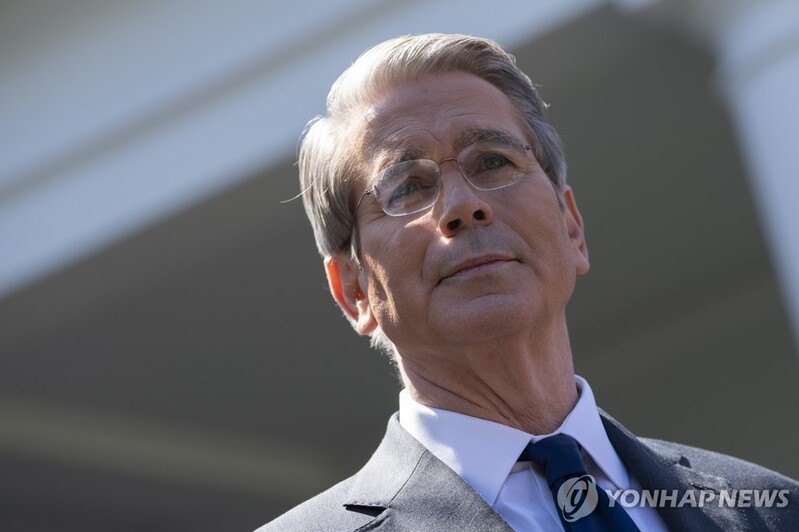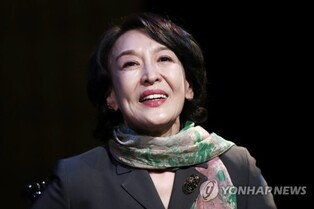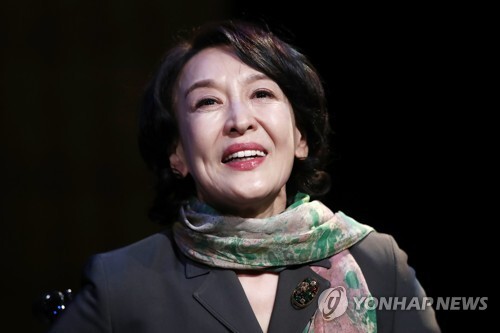 |
| ▲ U.S. Treasury Secretary Scott Bessent speaks to the media outside the White House in Washington on April 9, 2025 in this photo released by EPA. (Pool photo) (Yonhap) |
 |
| ▲ This file photo, released by Reuters, shows U.S. President Donald Trump meeting with Israeli Prime Minister Benjamin Netanyahu in the Oval Office at the White House in Washington on April 7, 2025. (Yonhap) |
(LEAD) Trump-tariffs
(LEAD) Trump temporarily lowers new tariffs on S. Korea, others to 10 pct in 90-day pause
(ATTN: RECASTS headline, lead; ADDS more info in paras 2, 8-18)
By Song Sang-ho
WASHINGTON, April 9 (Yonhap) -- U.S. President Donald Trump on Wednesday lowered new tariffs on South Korea and other trading partners to 10 percent in what he called a pause that will last for 90 days, while increasing duties on China to 125 percent following China's retaliatory move.
In a social media post, Trump made the announcement as "reciprocal" tariffs went into effect on the day, with dozens of countries striving to negotiate deals over new levies. Last week, his administration unveiled 25 percent tariffs on South Korea, 24 percent on Japan and 20 percent on the European Union, to name a few.
"I have authorized a 90 day PAUSE, and a substantially lowered Reciprocal Tariff during this period, of 10%, also effective immediately," Trump wrote on Truth Social.
He said he made the decision based on the fact that more than 75 countries have reached out to U.S. representatives, including the Department of Commerce, the Department of the Treasury and the U.S. Trade Representative for negotiations, and that these countries have not retaliated against new U.S. tariffs.
Trump reiterated his strong message against China, as Beijing announced a plan to raise tariffs on U.S. goods to 84 percent in a retaliatory move.
"Based on the lack of respect that China has shown to the World's Markets, I am hereby raising the Tariff charged to China by the United States of America to 125%, effective immediately," Trump said.
"At some point, hopefully in the near future, China will realize that the days of ripping off the U.S.A., and other Countries, is no longer sustainable or acceptable."
During a press availability later, Treasury Secretary Scott Bessent expounded Trump's 90-day pause while highlighting the Trump administration's desire to negotiate with countries to address trade barrier issues.
"Every country in the world who wants to come and negotiate ... We are willing to hear you," he told reporters. "We are going to go down to a 10 percent baseline tariff for them, and China (tariffs) will be raised to 125 (percent) due to their insistence on escalation."
He went on to say that new U.S. tariffs target "bad actors" while noting some of the "early" countries that the U.S. will meet for negotiations are China's neighbors, including South Korea, Japan, Vietnam and India.
Referring to the initially announced reciprocal tariff rates as being at "maximum levels," he noted room for negotiations.
"Like I said last week, the market did not understand those were maximum levels," he said. "The countries can think about those levels as they come to us to bring down their tariffs, their non-tariff trade barriers."
The secretary lambasted China as the "most imbalanced economy in the history of the modern world" and the "biggest source of U.S. trade problems," while accusing China of escalating trade tensions.
"I am not calling it a trade war, but I am saying that President Trump responded very courageously to that, and we are going to work on a solution with our trading partners," he said.
He also expressed expectations that countries will come to the U.S. with their "best deal" in tariff negotiations.
"As I said a week ago today, don't retaliate. Hold your ground. Let's see what happens," he said.
Trump has rolled out country-by-country reciprocal tariffs to equalize what other countries impose on U.S. goods as he has been using tariffs to increase federal government revenue, pare down America's trade deficits, draw in foreign investments and bolster domestic manufacturing.
The country-by-country tariffs were customized based on trading partners' tariff- and non-tariff barriers, as well as other factors, such as countries' exchange rate-related policies and practices, U.S. officials said.
(END)
(C) Yonhap News Agency. All Rights Reserved

































